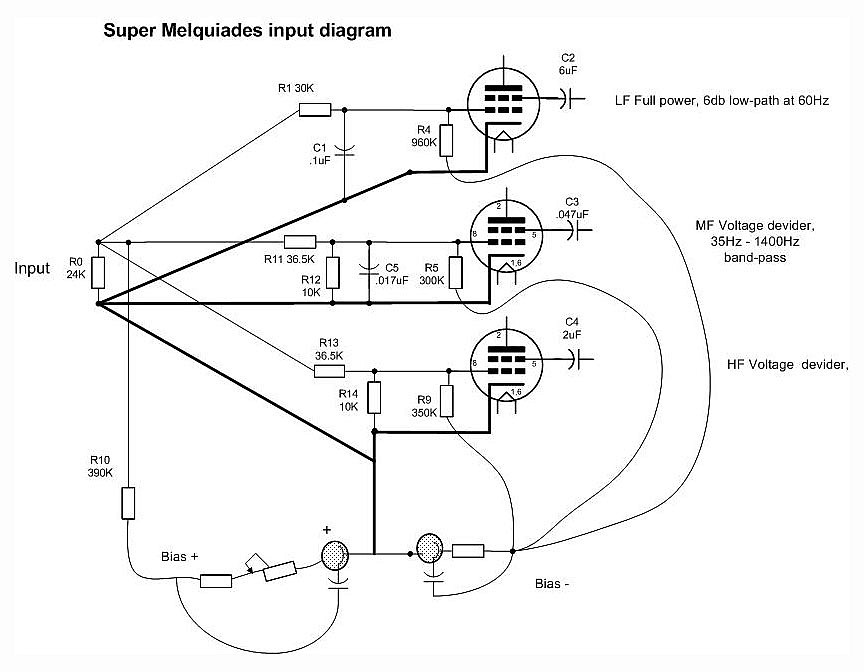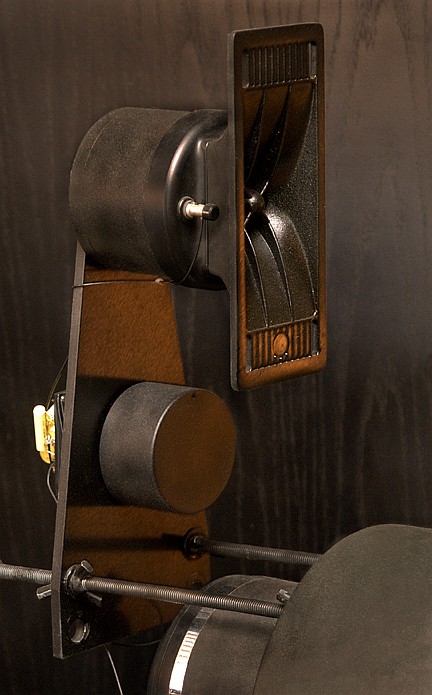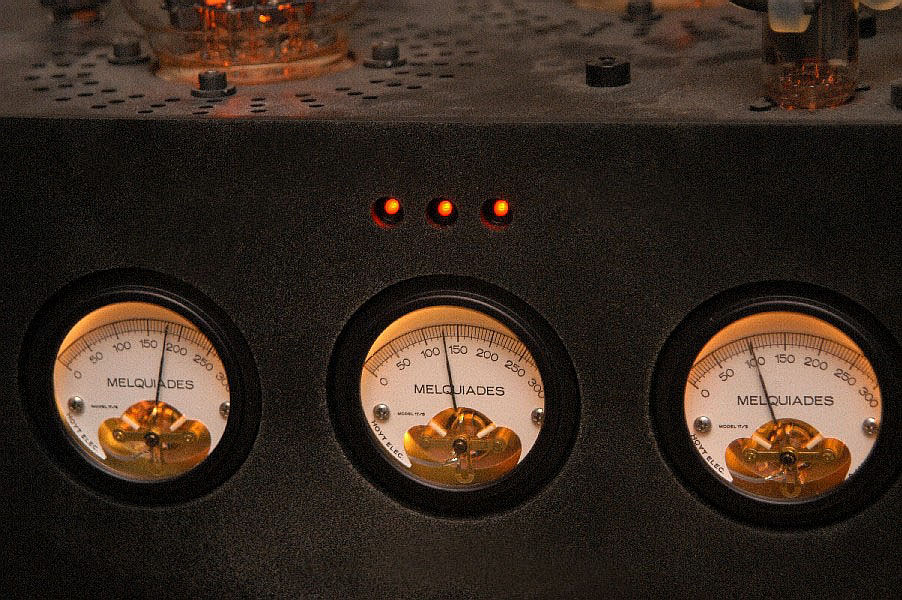Rerurn to Romy the Cat's Site
In the Forum: Melquiades Amplifier
In the Thread: Macondo – Super Melquiades: few months later.
Post Subject: Macondo – Super Melquiades: few months later. Posted by Romy the Cat on: 3/1/2006
Loudspeakers. For whomever who follows my dairies on this site and whoever has any real understanding what makes a horn-loaded loudspeaker to sound good it is know that Macondo Acoustic System is not juts the result of my DIY efforts or the John Hasqiun’s craft but rather a vision. Macondo is kind of a compilation of what might be done and what should not be done. Many believes of mine, visions and outcome of many experiments about horn loudspeakers were fulfill in the way how Macondo is organized. It looks simple and “as is” but in fact there is a lot of very much non-accidental decisions (and in the very many instances faulty decisions that were reviewed) that took place in Macondo loudspeaker. In the end the Macondo Acoustic System architecture is not something that was designed but something that “happened”. After many faulty decisions and many faulty directions were filtered out the architecture that left…. turned into something that become the Macondo Acoustic System. (Look in “My Playback” for more)
Amplifiers. The playback-wise, the 2005 was a big Melquiades year for me. The original single Melquiades was built in January 2005 and in March I made a decision to pursue a DSET (Dedicated SET) – The Super Melquiades or the configuration when each Macondo channels would be driven by an IDENTICAL separate channel with only output transformer optimized for the need of the specific frequency range. The Super Melquiades was finished I believe in June-July 2005 and since then it is running in my system.
http://www.goodsoundclub.com/Melquiades.aspx
Since Super Melquiades was “deployed to the duty” there were a few very-very minor, practically negligible changes done to it’s circuit. None of them affect topology but rather the minor optimizations with a context of my playback and in the context of the Macondo–Melquiades integration. After a few month of running the Super Melquiades DSET coupled with Macondo I would like to share with you some notes that I have made.
Generally a multi-way (horn) installation and the dedicated identical SETs driving them is a phenomenal architecture. Beside all sonic, practical, integration and technical advantages the architecture has some extra benefits that people who do not have this setting can hardly be familiar with. I’m talking about the fact that when the identical DSETs drive own channels then there is an opportunity to very-very precise, in real time, to dial in Sound or to shape the sonic presentation with unheard flexibility. Of course the gains between the channels are fixed and the basic loading of the output anodes are fixed (optimized for the drivers/incisures).

However, there is always opportunely to use the plate currents creatively and those affects are very different then it would be with a single SET driving the entire system.
Let look at the LF channel. The Macondo’s LF line array with six Scan-speak 25W/8565 drivers in sealed enclosure, line-crossed at 65Hz with fist order, driven by the Super Melquiades’ LF channel are is superbly sensitive for damping. Actually it is more sensitive that anything else I have seen. Even a half Ohm is auditable, very auditable! The LF Melquiades drives the tower with 230V and 175 “default” mA, loading the plate of the 6C33C with 560R. However, the Melquiades’ output stage can perfectly handle much larger current (the transformer is gaped at 450mA with 15H primary) and running the palate current form 100mA to 270mA it is possible to “change” bass. The key in here: what kind change it might be. With increase of current the bass’s amplitude very slightly go up, very-very slightly. However, the intensity and expressiveness of bass is changing as well and this change is more important Yes, I understand that with change of plate current changes the plate impedance and consequentially the damping. However, I have another OPT with 3 more ohms and I can testify that it is not juts the damping. All together this all boil down that increasing the plate current on Melquiades LF channels adds presentational effectiveness of bass, however the decreasing the current adds quality to the bass. By decreasing the plate current, I loose power but get the LF bandwidth, still it would be only when I would be near the maxing out the DC capacity of my OPT. In my case, operating it near 200mA, and having the 450mA transformer I am very far from any danger of saturation…. Anyhow, the running the LF channel between the 150mA and 210mA turns out to be a correct setting and although the change with this scope hardly affect the amount of bass but this change is quit affective from the prospective to get out of the system that “idiosyncratic bass”. The “plate current running” gives an ability (literally) to conduct the bass instruments and to make them to accent themselves with a necessary articulation. This is very, very cool tool and this is the tool that I never was able to use before, while I drove my LF section with other amps, including the Lamm ML2.
Let look at the upper bass channel. It is 35Hz-1400kHz electrically line-level and 95Hz–1000kHz acoustically. First off all the upper bass coil do not talk with MF driver that is unheard in a case of a single-amping. Moreover, the beauty of adjusting of plate current at the upperbass channel is the real important thing and this upperbass plate current attenuator is the most frequently used by me attenuator in the entire Super Melquiades. People who do not use properly built upperbass horns do not know anything about the upperbass reproduction. Unfortunately among the people who do use upperbass horns mostly still are in dark. The key in upperbass is that the upperbass-midbass drivers should be as small as possible. The folks who use 15”-18” drivers to reproduce upperbass do not use in fact any horn-loading at all… So, how the plate current within “a proper upperbass channel” would affect midbass Sound? Contrary to the lower bass channel the dumping in midbass is less effective, prefabs because my upperbass driver is properly “held” with own back chamber. For upper bass drive the Super Melquiades uses a half of 6C33C driving it with 230V with “default” 125mA behind the OPT ~8H primary and 250mA gap. Adjusting the plate current form 100mA to 150mA it is possible to change the … a volume of Sound in the room. I am not talking about changing the loudness of the upperbass but rather it’s physical volume and it’s capacity in a room. I usually call it “The Accordion Effect” ™. It is like a clarinet bridges in an orchestra the string groups and woodwinds…The upperbass channel in a playback does the same bridging the LF and MF channel. It has nothing to do with the forwardness or amplitude of upperbass - it does not change with the change of the plate current, the question is “HOW?”. It might do it by loading a room with something that become “sticky” to the dimensions of the room as well as the to the sound of LF and MF channels. The “The Accordion Effect” is an effect when the room suddenly begins to “puff back” (listen some Bruckner). In order to do so the room should be very precisely filled with…..**** (fill in blank) and it is very easy to do by dialing-in the plate current at the upperbass chanla. Usually, when I want to be anal, I increase the upperbass plate current unit “The Accordion Effect” is just shows up and then I reduce the plate current for a 2 turn on my 10-turs Burns, considering that it would be the correct setting… for the given recoding and the given state of the damn electricity… Usually 100mA and 150mA is good values for the upperbass channel.
Let look at the MF channel. It is It is 3.7KHz speaker-level high-pass electrically and 1 kHz acoustically. For the MF channel the Super Melquiades uses a half of 6C33C driving it with the same 230V with “default” 110mA behind the OPT ~1H primary, gaped at 250mA. I allow the current vary between the 100mA and 135mA. Actually with 110mA and 6E6PDR in input sate I feel that the MF channel performs fine and I never go higher. If I need more HF then I have the HF transition slope adjuster and I might add as much HF as I need.

The only reasons why I go sometimes for 125mA-135mA at the MF channel when some audiophiles – the morons brewed on the steel tweeters and overly exuberate sound - visit me and they want to hear their “definition of quality”. Those Morons ™, until they do not hear the sharp, overly presumptuous and irrationally vigorous HF they experience the “deficiency of air in sound”. So, usually I turn up for them the MF plate current too keeps those hoodlums happy. If I do not do so then they do not hear “resolution” and do not get their “details from the grooves”
This pretty much how my setting looks like for my own “default” listening:

Generally the Macondo – Super Melquiades system proved to be very flexible, very versatile and very adaptive. It is not finicky and not tweaky but form another perspective if I wish then it offers some tools that allow shaping Sound upon my needs. Among the imperfection I would mention the mains voltage fluctuation. It could be fixed only by regulation with all negative sonic consequences of regulation. Another problem is the 6C33C tubes themselves that have different characteristics to begin with and then they age with deferent tempos (remember The Melquiades uses fixed bias). Thanks God I built in the Super Melquiades the opportunities to test 6C33C while it is working but still the out stage requires monitoring 6C33C once per 2-3 month.
Rgs,
Romy the CatRerurn to Romy the Cat's Site